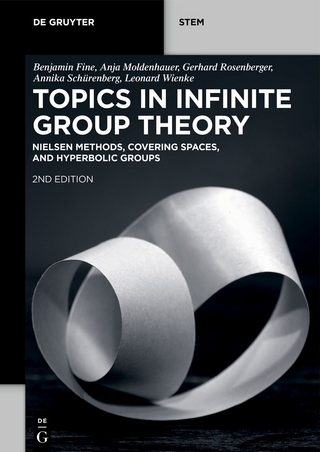
Equivariant, Almost-arborescent Representations of Open Simply-connected 3-manifolds
A Finiteness Result
2004
American Mathematical Society (Verlag)
978-0-8218-3460-2 (ISBN)
American Mathematical Society (Verlag)
978-0-8218-3460-2 (ISBN)
- Titel ist leider vergriffen;
keine Neuauflage - Artikel merken
Shows that at the cost of replacing $V^3$ by $V_h^3 = /{V^3$ with very many holes $/}$, we can always find representations $X^2 /stackrel {f} {/rightarrow} V^3$ with $X^2$ locally finite and almost-arborescent, with $/Psi (f)=/Phi (f)$, and with the open regular neighbourhood Nbd$(fX^2)=V^3_h$.
When one extends the (almost) collapsible pseudo-spine representation theorem for homotopy $3$-spheres [Po3] to open simply connected $3$-manifolds $V^3$, new phenomena appear: at the source of the representation, the set of double points is, generally speaking, no longer closed. We show that at the cost of replacing $V^3$ by $V_h^3 = /{V^3$ with very many holes $/}$, we can always find representations $X^2 /stackrel {f} {/rightarrow} V^3$ with $X^2$ locally finite and almost-arborescent, with $/Psi (f)=/Phi (f)$, with the open regular neighbourhood (the only one which is well-defined here) Nbd$(fX^2)=V^3_h$ and such that on any precompact tight transversal to the set of double lines, we have only finitely many limit points (of the set of double points).Moreover, if $V^3$ is the universal covering space of a closed $3$-manifold, $V^3=/widetilde M^3$, then we can find an $X^2$ with a free $/pi_1M^3$ action and having the equivariance property $f(gx)=gf(x)$, $g/in /pi_1M^3$. Having simultaneously all these properties for $X^2/stackrel{f} {/rightarrow} /widetilde M^3$ is one of the steps in the first author's program for proving that $/pi_1^/infty /widetilde M^3=[UNK]0$, [Po11, Po12]. Achieving equivariance is far from being straightforward, since $X^2$ is gotten starting from a tree of fundamental domains on which $/pi_1M^3$ cannot, generally speaking, act freely. So, in this paper we have both a representation theorem for general ($/pi_1=0$) $V^3$'s and a harder equivariant representation theorem for $/widetilde M^3$ (with $gfX^2=fX^2, /, g/in/pi_1M^3$), the proof of which is not a specialization of the first, 'easier' result.But, finiteness is achieved in both contexts. In a certain sense, this finiteness is a best possible result, since if the set of limit points in question is $/emptyset$ (i.e. if the set of double points is closed), then $/pi_1^/infty V_h^3$ (which is always equal to $/pi_1^/infty V^3$) is zero. In [PoTa2] it was also shown that when we insist on representing $V^3$ itself, rather than $V_h^3$, and if $V^3$ is wild ($/pi_1^/infty/not =0$), then the transversal structure of the set of double lines can exhibit chaotic dynamical behavior. Our finiteness theorem avoids chaos at the cost of a lot of redundancy (the same double point $(x, y)$ can be reached in many distinct ways starting from the singularities).
When one extends the (almost) collapsible pseudo-spine representation theorem for homotopy $3$-spheres [Po3] to open simply connected $3$-manifolds $V^3$, new phenomena appear: at the source of the representation, the set of double points is, generally speaking, no longer closed. We show that at the cost of replacing $V^3$ by $V_h^3 = /{V^3$ with very many holes $/}$, we can always find representations $X^2 /stackrel {f} {/rightarrow} V^3$ with $X^2$ locally finite and almost-arborescent, with $/Psi (f)=/Phi (f)$, with the open regular neighbourhood (the only one which is well-defined here) Nbd$(fX^2)=V^3_h$ and such that on any precompact tight transversal to the set of double lines, we have only finitely many limit points (of the set of double points).Moreover, if $V^3$ is the universal covering space of a closed $3$-manifold, $V^3=/widetilde M^3$, then we can find an $X^2$ with a free $/pi_1M^3$ action and having the equivariance property $f(gx)=gf(x)$, $g/in /pi_1M^3$. Having simultaneously all these properties for $X^2/stackrel{f} {/rightarrow} /widetilde M^3$ is one of the steps in the first author's program for proving that $/pi_1^/infty /widetilde M^3=[UNK]0$, [Po11, Po12]. Achieving equivariance is far from being straightforward, since $X^2$ is gotten starting from a tree of fundamental domains on which $/pi_1M^3$ cannot, generally speaking, act freely. So, in this paper we have both a representation theorem for general ($/pi_1=0$) $V^3$'s and a harder equivariant representation theorem for $/widetilde M^3$ (with $gfX^2=fX^2, /, g/in/pi_1M^3$), the proof of which is not a specialization of the first, 'easier' result.But, finiteness is achieved in both contexts. In a certain sense, this finiteness is a best possible result, since if the set of limit points in question is $/emptyset$ (i.e. if the set of double points is closed), then $/pi_1^/infty V_h^3$ (which is always equal to $/pi_1^/infty V^3$) is zero. In [PoTa2] it was also shown that when we insist on representing $V^3$ itself, rather than $V_h^3$, and if $V^3$ is wild ($/pi_1^/infty/not =0$), then the transversal structure of the set of double lines can exhibit chaotic dynamical behavior. Our finiteness theorem avoids chaos at the cost of a lot of redundancy (the same double point $(x, y)$ can be reached in many distinct ways starting from the singularities).
Introduction The case $V^3=/widetilde M^3$ of Theorem I and Theorem II The accumulation pattern of the double point $M_2(f)/subset X^2$ Arbitrary open simply-connected 3-manifold Bibliography.
| Erscheint lt. Verlag | 1.4.2004 |
|---|---|
| Reihe/Serie | Memoirs of the American Mathematical Society |
| Zusatzinfo | illustrations |
| Verlagsort | Providence |
| Sprache | englisch |
| Themenwelt | Mathematik / Informatik ► Mathematik ► Geometrie / Topologie |
| ISBN-10 | 0-8218-3460-6 / 0821834606 |
| ISBN-13 | 978-0-8218-3460-2 / 9780821834602 |
| Zustand | Neuware |
| Haben Sie eine Frage zum Produkt? |
Mehr entdecken
aus dem Bereich
aus dem Bereich
Gekrümmte Kurven und Flächen
Buch | Softcover (2024)
De Gruyter (Verlag)
CHF 76,90
Nielsen Methods, Covering Spaces, and Hyperbolic Groups
Buch | Softcover (2024)
De Gruyter (Verlag)
CHF 153,90


